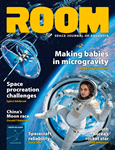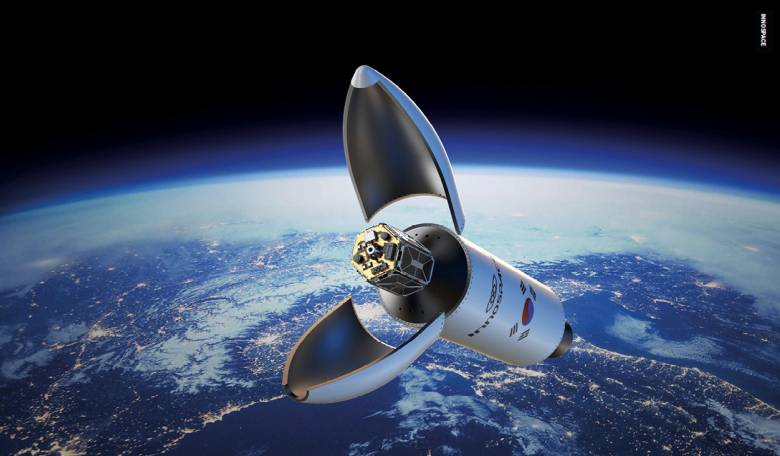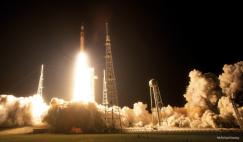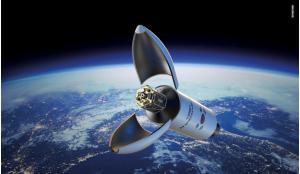A South Korean commercial launch vehicle company, INNOSPACE, which is planning to capitalise on increasing global demands for affordable launch services, enhanced its visibility with a stand at the 2024 International Astronautical Congress in Milan, Italy, where ROOM Editor Mark Williamson spoke to Chief Global Business Officer, Win Marshall Bronzewall.
Of all the nations around the world striving to build a space industry, one rarely considers South Korea which did not even have a space agency until May 2024 when the Korea Aerospace Administration (KASA) replaced the Korea Aerospace Research Institute (KARI) as the lead government organisation for space research. It is therefore particularly interesting to discover that the nation is home to a commercial satellite launch vehicle company called INNOSPACE, which is entirely venture-capital funded.
 ROOM Editor-in-Chief Clive Simpson (right) with INNOSPACE Chief Global Business Officer, Win Marshall Bronzewall, during IAC 2024 in Milan.
ROOM Editor-in-Chief Clive Simpson (right) with INNOSPACE Chief Global Business Officer, Win Marshall Bronzewall, during IAC 2024 in Milan.
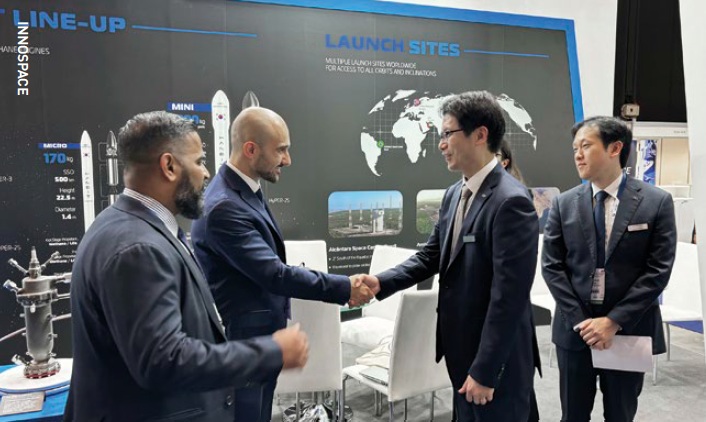 CEO of INNOSPACE Soojong Kim greeting Guido Parissenti, CEO of Apogeo Space, an Italian customer, at the IAC 2024 exhibition booth, Milan, Italy.
CEO of INNOSPACE Soojong Kim greeting Guido Parissenti, CEO of Apogeo Space, an Italian customer, at the IAC 2024 exhibition booth, Milan, Italy.
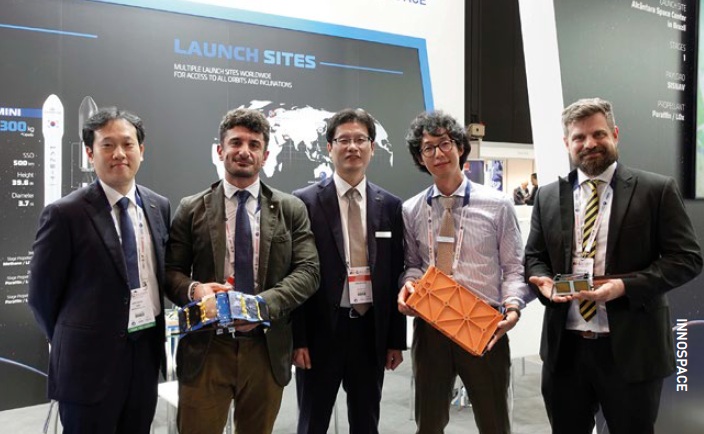 INNOSPACE introducing the HANBIT launch vehicle and its core technologies to visitors in Milan.
INNOSPACE introducing the HANBIT launch vehicle and its core technologies to visitors in Milan.
 INNOSPACE meeting with Italian satellite company CShark on the first day of the IAC 2024 exhibition.
INNOSPACE meeting with Italian satellite company CShark on the first day of the IAC 2024 exhibition.
Established in 2017, INNOSPACE took advantage of the 75th International Astronautical Congress (IAC) - held in Milan, Italy, in October 2024 – to flag its existence to the wider space community. Its Chief Global Business Officer, Win Marshall Bronzewall, characterised the company as a “Korean aerospace and defence start-up”, a launch service provider currently providing launches for small satellites but with much grander plans.
In March 2023, INNOSPACE marked the successful test launch of its HANBIT-TLV (Test Launch Vehicle)
The company has about 200 employees in Korea and a handful in subsidiary offices in Brazil, Paris and Dubai. Its primary launch site is Brazil’s Alcantara Space Centre, but it also has a secondary launch site in Australia’s Northern Territory (the Arnhem Space Centre) and is planning to launch from the Andøya Spaceport in Norway and, later, from the United Arab Emirates (UAE). Perhaps not surprisingly, a launch site in Korea is also under development and, according to Bronzewall, is expected to be available by late 2026 or early 2027.
In March 2023, INNOSPACE marked the successful test launch of its HANBIT-TLV (Test Launch Vehicle), which founder and CEO Soojong Kim called “a significant milestone as the first privately developed launch vehicle in South Korea”. The suborbital rocket was launched from Alcantara to verify the flight performance of the company’s hybrid rocket engine, which will be used across the range of HANBIT vehicles, its inertial navigation system and other subsystems.
Current plans call for the development of three operational vehicles: the HANBIT-Nano, with the capacity to launch payloads of 90 kg to a 500 km-high sun-synchronous orbit (SSO); the HANBIT-Micro, which can lift 170kg to the same orbit; and the HANBIT-Mini, with a launch capability of 1300kg to SSO.
Maiden launches of the three variants are scheduled, respectively, for July 2025, September 2025 and late 2026, which is an aggressive timescale by any analysis. Bronzewall insists that INNOSPACE is able to scale-up from one vehicle to another at such a rapid pace because “we are not re-inventing the engine; we are just adding components in a new configuration”. Of course, the ability to move from one variant to the next in rapid succession will depend ultimately on the success, or otherwise, of each individual launch.
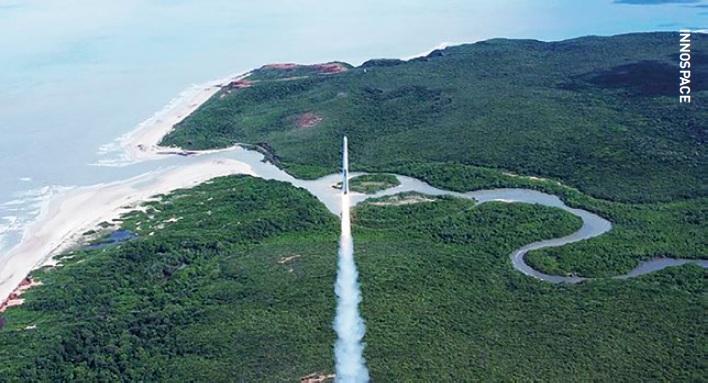 First test launch vehicle HANBIT-TLV successfully launched from the Alcântara Space Center in Brazil in March 2023.
First test launch vehicle HANBIT-TLV successfully launched from the Alcântara Space Center in Brazil in March 2023.
 Sequence showing the separation of the first stage (top) and second stage (bottom) of the HANBIT-Nano.
Sequence showing the separation of the first stage (top) and second stage (bottom) of the HANBIT-Nano.
Hybrid rockets
Current plans call for the development of three operational vehicles: the HANBIT-Nano… the HANBIT-Micro… and the HANBIT-Mini
Bronzewall, however, is unperturbed by the patchy history of maiden flights and concentrates, instead, on what makes his company different. He puts its fast-track launch vehicle development down to a “unique” propellant combination, whereby the HANBIT system is based on a hybrid first stage, using paraffin as the fuel and liquid oxygen (LOx) as the oxidiser, and a methane-LOx upper stage. He explained that “the hybrid is unique because the manufacturing cost and lead-time is much lower. We don’t need any special equipment for manufacturing and the paraffin part is non-explosive, which reduces all our handling costs”. As a result, he claims that INNOSPACE was “first to actually launch a hybrid rocket… currently the largest in the world at 15 tonnes [of thrust]”.
So what does the three-vehicle HANBIT system look like in terms of specifications? The HANBIT-Nano is about 21.8 m tall and 1.4 m in diameter. Its first stage hybrid engine (known internally as ‘HyPER’) is designed to develop 245 kN of thrust and burn for 150 seconds; the upper stage methane engine (‘LiMER’) develops 29 kN and burns for 300 seconds.
The HANBIT-Micro is a shade taller at 22.5 m and uses the same first stage, but it adds a second stage, with two 29 kN methane-LOx engines, and a 4 kN methane-LOx ‘kick stage’ (for final orbital insertion).
The HANBIT-Mini is a much larger vehicle, at 39.6 m tall and with a 3.7 m-diameter first stage featuring a cluster of nine hybrid engines. The first stage thrust is rated at 9x245kN (as it uses nine of the standard hybrid engines); the second stage delivers 245kN (since it is effectively the first stage of the smaller vehicles); and the third stage produces 2x29kN (the same as the second stage of the Micro). The design philosophy of using standardised stages and engines to build vehicles of different sizes is a tried-and-tested method and helps to simplify production lines, reduce costs and accelerate experience (or ‘heritage’) of the various technologies.
The company’s business model of transferring cost reductions to customers appears to be bearing fruit. Bronzewall confirms that INNOSPACE has customers from Asia, Europe and Brazil for each of its rocket variants, adding: “We have customers from USA that have already signed up for a multiple launch contract.”
Asked to compare launch costs with their closest competitor, Bronzewall says: “Official pricing details of other competitors are not publicly available for precise comparison. We’re launching at around US$33,000 per kilogram. For the larger launch vehicle, the HANBIT-Mini, the cost is about US$12,000 per kilogram. I am confident that these are competitive prices.”
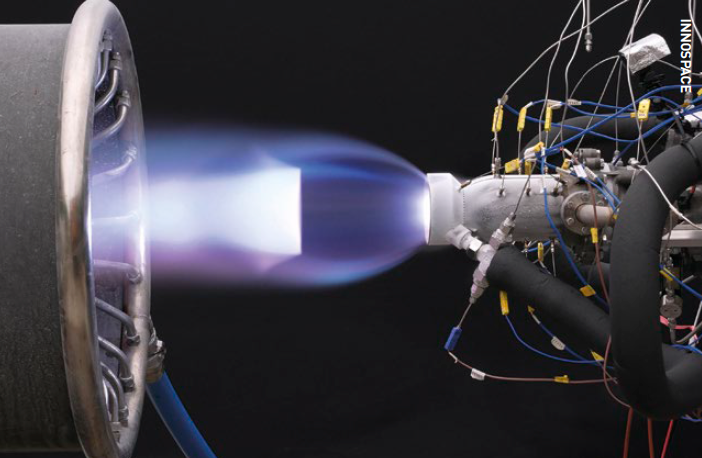 Hot-fire test on the three-ton class methane thrust chamber assembly for the upper stage of ‘HANBIT-Nano’.
Hot-fire test on the three-ton class methane thrust chamber assembly for the upper stage of ‘HANBIT-Nano’.
Launch testing
The HANBIT system is based on a hybrid first stage, using paraffin as the fuel and liquid oxygen (LOx) as the oxidiser, and a methane-LOx upper stage
On 9 September 2024, INNOSPACE successfully conducted a payload fairing separation test, a key step in technology development which it considers to be “the final gateway to safely place a satellite in orbit”. This augurs well for the HANBIT-Nano launch planned for July 2025 when the company will ‘test in anger’ the 2.6 m tall carbon composite fairing with a payload inside. The payloads for this inaugural launch from Alcantara will include satellites from Brazilian customers including the Federal University of Maranhão (UFMA) and Castro Leite Consultoria LTDA (CLC).
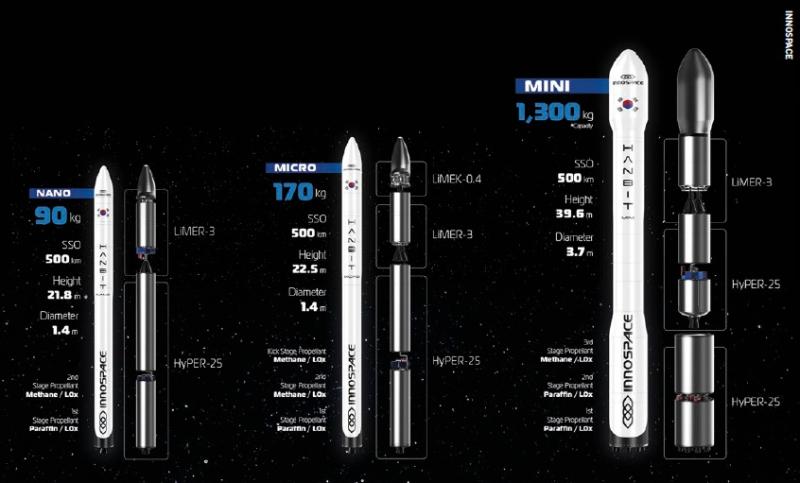 Specifications for the three-vehicle HANBIT system.
Specifications for the three-vehicle HANBIT system.
Currently, fairing separation is achieved using a pyrotechnic nut, which splits when activated to force the two clamshell sections apart. In the next stage of development, the company plans to introduce a separation device using shape-memory alloy, a metal alloy that returns to its original shape when heated (as if ‘remembering’ the former configuration). According to the company, this technical solution is lightweight and performs well in high-temperature environments “to minimise the impact on the satellite when the fairing is separated”.
INNOSPACE CEO Kim Soojong was particularly pleased with the results of the test because it helped to “prove to our customers that we are carrying out the planned schedule and important technical steps for the development of HANBIT-Nano”. This customer-focused philosophy is apparent throughout the company’s press statements and marketing materials to a much greater extent than with the most western companies. From the outside, it is difficult to know whether this is simply ‘marketing-speak’ or ‘culturally influenced’, but the answer will surely come as the company transitions from the promissory phase to launch operations.
The HANBIT-Nano inflight test had originally been scheduled for March 2025 but the launch was pushed back when the company announced a change in late December due to delays in the supply of components for the launch vehicle’s electric pump and the construction of a new integrated test facility in South Korea. INNOSPACE said the delays affected the launch vehicle’s hardware production timeline and testing schedules.
In a statement issued at the time it added: “The development of a satellite launch vehicle demands high precision, optimisation and collaboration across a wide network of partners - from securing key technologies to producing hardware – and unexpected challenges at various stages can significantly impact the overall project timeline.”
On 9 September 2024, INNOSPACE successfully conducted a payload fairing separation test, a key step in technology development
INNOSPACE said it would address such challenges by implementing a “diversification strategy” for its supply chain by identifying alternative suppliers for critical components and minimising reliance on single-source providers through both domestic and international networks.
One-stop shop
In terms of a vision of the future for the new Korean launch provider, INNOSPACE has plans to “spread its wings across the whole value chain”, as Bronzewall puts it. “We want to get into satellite manufacturing and then into producing and supplying the data,” he adds, initially as an in-house project but later considering mergers and acquisitions should the opportunities arise. But this is not the end of their ambitions, however: “even further in the future we are also thinking about human spaceflight,” says Bronzewall. “We want to be a one-stop shop!”
Asked how he would characterise the company’s relationship with the new Korean space agency, KASA, he said: “The space agency has just been formed, so they are trying to find their way, but I’ve heard that they are planning bigger projects for next year, which we are definitely thinking of becoming a part of.”
So how does CEO Soojong Kim feel about the company’s first major outing among the global space community? “Participating in this year’s IAC exhibition was a meaningful opportunity to showcase INNOSPACE’s technological innovations and launch service competitiveness to global space experts and potential customers,” he stated. “We are committed to continuous technological development and launch service innovation to help customers access space more easily and quickly.”
Indeed, according to its mission statement, INNOSPACE is dedicated to “innovation in the small satellite launch market with low-cost, customized rapid launch solutions” that will contribute to “the creation of a new space for sustainable humanity”.
It is all too easy to become ‘western-centric’ when it comes to NewSpace innovation, but Europe and America would do well to ‘look east’ from time to time. While there are few guarantees of success, especially in the launch business, there is no guarantee of a monopoly either.
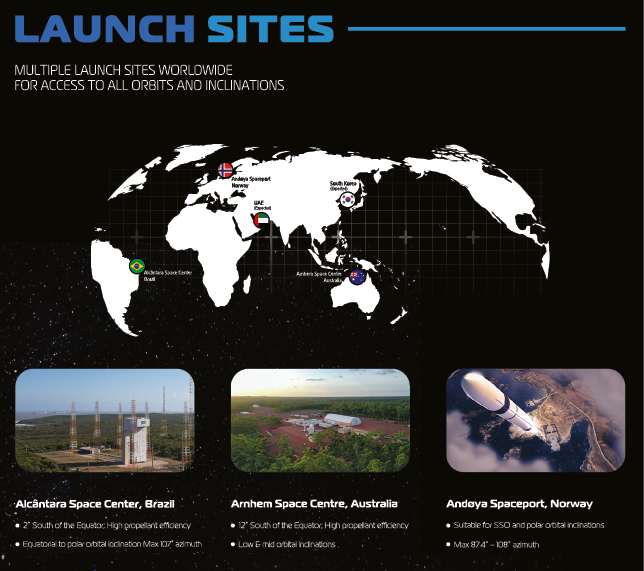
About the author
Mark Williamson is an independent Space Technology Consultant and writer, and a Commissioning Editor for ROOM Space Journal. He has 40 years of experience as a satellite communications engineer and consultant to the space industry, space insurance and space education sectors. He is the author of six books, including The Cambridge Dictionary of Space Technology and Space: The Fragile Frontier, has edited three space industry magazines and written more than 600 articles and papers on space technology. He has a BSc in physics and astrophysics from Queen Mary London and a PhD in sustainable development of the space environment, and is a chartered physicist and chartered engineer.


